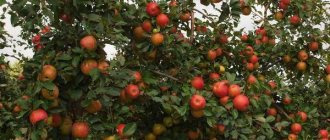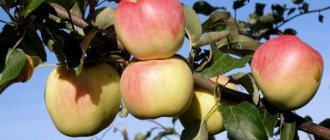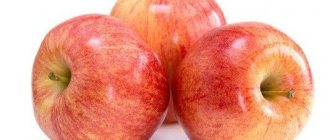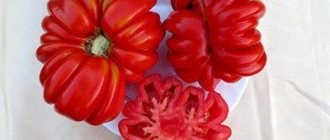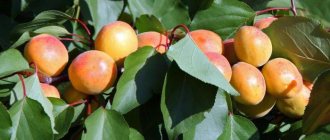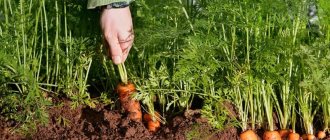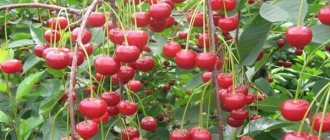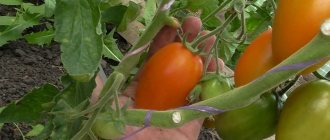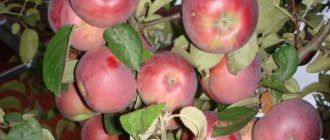Honey Crisp is one of the best modern varieties. And although it was developed in the last century, for many Russian gardeners it remains a novelty. The advantages of the variety are beautiful and large fruits, excellent taste, high yield, frost resistance. But there are also weaknesses that should be taken into account when growing.
- 2 Description of the variety
2.1 Video: garden with Honey Crisp during flowering and fruiting periods
- 3.1 Video: review of Honey Crisp apples
- 4.1 Classic care for Honey Crisp
- 5.1 Video: about the need to ration apple trees
Origin of Honey Crisp
The variety was bred in 1974 in the American state of Minnesota. Breeders pursued the goal of improving the Honey Gold apple tree by increasing its winter hardiness. Makaun, bred back in the 1960s, was chosen as a pollinator. Seedlings grew from the seeds. Later, for its crispy pulp and honey taste when fully ripe, the variety was named Honey Crisp, that is, “honey crunch.” In 1991, the seedlings went on sale and have since spread not only throughout all states of America, but also in Canada, Europe, and now the variety is gaining positive reviews in Russia.
Honey Crisp is a very productive and beautiful variety
Description of the variety
Honey Crisp is grown on medium-sized and dwarf rootstocks. The crown of a young tree up to four years old has a narrow oval shape; with age it becomes broadly oval, but remains compact. Due to its frost resistance, the variety can be grown in the middle zone and Siberia. The apple tree tolerates low temperatures down to -35 ⁰C.
Compared to many varieties, Honey Crisp is distinguished by its high resistance to fungal diseases, in particular, even in wet years it does not suffer from scab and powdery mildew. Excessive yields can lead to rest the following year, that is, periodicity is observed. It begins bearing fruit on medium-sized rootstocks in the fourth year, on dwarf rootstocks in the second. A cutting grafted into the crown of an adult apple tree will bloom the next year.
Video: garden with Honey Crisp during flowering and fruiting periods
Reviews from gardeners about the variety
Honey Crisp needs warmth. Last year it ripened perfectly for me. The taste after two weeks of storage was amazing. The acidity goes away when it sits, sweetness is added, but everything is fine there anyway. This cold year is empty. But very juicy and crispy, as it should be. The appearance of an apple greatly depends on the lighting. In the shade, without any coloring at all, or with dirty stripes, in the sun - just like in the picture they turn out from the exhibition. I haven’t tried storing it, but it seems to last until February.
Andrey Vasiliev
https://www.forumhouse.ru/threads/58649/page-54
A small detail in favor of the Honey Crisp variety: those “charms” that the autumn frosts left us with, such as drying out of branches on certain varieties, uprooting and replacing other varieties, did not affect this apple tree in any way. No damage, excellent growth, beautiful shiny leaf.
Vladimir Zavada
https://forum.vinograd.info/showthread.php?p=1162135
The first fruiting of Honey Crisp in the third year from the moment of planting: the yield is about two buckets (this is with thinning). The fruits are all large, more than 200 g, some were about 400 g. More than half of the fruits are affected by subcutaneous spotting. Apples are beautiful and tasty.
Nikaaienne
https://forum.vinograd.info/showthread.php?p=1162135
Honey Crisp has a harmonious taste. Neither Antonovka nor Belyi Nalivka were even close.
Elsa30
https://domorost.ru/topic/592/%D1%8F%D0%B1%D0%BB%D0%BE%D0%BD%D1%8F
Honey Crisp apples are valued primarily for their attractive appearance and excellent taste. But the advantages of the American winter variety are far from exhausted. Of course, there are nuances of care that need to be learned in advance, but an apple tree cannot be called capricious and demanding of agricultural technology.
- Author: admin
Rate this article:
- 5
- 4
- 3
- 2
- 1
(3 votes, average: 5 out of 5)
Share with your friends!
Productivity and characteristics of fruits
The fruits reach harvest ripeness by mid-September, marketable ripeness by mid-October, and are stored fresh for 6 months. The apples are large, weighing 180–300 g; in the sun they turn a speckled red blush, and in the shade they remain green. The shape of the fruit is round-conical, but there are also asymmetrical and flattened ones. The reason is the short stalk and high fertility. From one inflorescence 3–4 apples grow, which crowd each other and are often squeezed out, causing them to fall off.
Due to the short stalk, Honey Crisp fruits are located tightly to each other
Gardeners who grow apple trees, including Honey Crisp, say that this variety surpasses others with amazing taste. The flesh is crispy, juicy, bites off with a chip. Even Honey Crisp that has wilted during storage retains its crunchiness. The taste is sweet with sourness and a subtle aroma, but in the northern regions the sourness will be more noticeable. The sugar content also depends on how warm the summer was.
Video: Honey Crisp apple review
Positive and negative qualities of the variety
The list of advantages of the Honey apple tree, in comparison with other varieties, includes:
- Winter hardiness;
- Resistance to scab and fruit rot diseases;
- Stable abundance of harvest;
- Apples are not subject to shedding;
- Sugary consistency of fruits;
- Excellent taste;
- Bright apple aroma;
- Suitable for long-term storage;
- Easy to care for;
- No need for special treatments.
The disadvantages of the variety are:
- The need to maintain the shape of the crown;
- Roots react poorly to stagnant water;
- Susceptibility of the bark to damage by rodents.
The Honey Apple tree is a summer variety, very popular among domestic gardeners for its dessert fruits and the tree’s low maintenance requirements. In addition, this variety is suitable for cultivation in many regions of the country.
Features of cultivation
For higher yields, plant the apple tree next to other varieties. Good pollinators are: Idared, Askolda, Golden Delicious, Everest and others, blooming in the same period. Before entering fruiting, caring for Honey Crisp is the same as for any seedling. This mainly involves watering and forming the crown according to the usual principle for a tree - one trunk and 5-6 skeletal branches.
Apple tree Honey Crisp on a dwarf rootstock
Classic care for Honey Crisp
If your region experiences frosts below -35 ⁰C, then in the spring you need to carefully inspect the trunk and skeletal branches. Due to freezing of the bark, cracks may form and gum formation may begin. If wounds are found, clean them down to healthy wood, disinfect them with a solution of copper sulfate (10 g per 1 liter of water) and cover them with garden varnish. Trim frozen branches.
Activities that need to be carried out in the spring, before the buds open or along the green cone and during the budding period:
- spraying with an insecticide solution (Karbofos, Iskra, etc.) against pests that feed on buds, tender greens and buds;
- treatment against diseases, Honey Crisp is resistant to them, so you can get by with preventive spraying with a solution of the biological product Fitosporin;
- watering and fertilizing with nitrogen-containing fertilizers, these two agricultural practices can be combined: first fill the irrigation ditch or hole with clean water, when it is absorbed - with liquid fertilizer (a solution of urea, ammonium nitrate or nitroammophosphate) and again with clean water.
Continue pest control throughout the summer. Immediately after flowering and 1-2 more times with an interval of 10 days, treat with insecticides against leaf-eating pests and codling moths. During the period of fruit filling, another watering is needed, combined with root feeding, but with fertilizers containing potassium, phosphorus and microelements.
Video: how and what to feed fruit trees
Planting and care
Planting an apple tree and abundant watering
Unlike summer apple varieties, winter varieties can be stored longer. A good argument in favor of the variety discussed in this article is undoubtedly its resistance to diseases and, in particular, to scab.
When a suitable place is chosen for planting Honey Crisp, its average height must be taken into account. For this reason, no less than 3 m is left to the nearest buildings and trees.
The level of groundwater plays an important role in the formation of a good tree. If they are known to be close to the surface, this value is about 3 m, tree roots may be negatively affected, and frost resistance tends to be significantly reduced in such cases. If these waters are even closer, for example, up to 2 m, it is necessary to plant the seedling on an elevated, dry bed, the so-called verey.
Important! When purchasing seedlings, you should choose annual or biennial ones, at this age they have the ability to take root faster
You also need to pay attention to branches and roots. If the seedlings are good, they should be without damage and have elasticity.
When planting in autumn, the pit for the seedling is prepared a month in advance. The landing dates are directly tied to weather conditions. There should be at least 3 weeks left before frost. If for some reason it was not possible to plant before frost, you can bury the tree. It is also preferable to prepare a pit for planting seedlings in the fall in the fall.
To plant a seedling, prepare a hole about 70 cm deep, and its diameter should be 1 meter. The primer is prepared as follows by mixing the components:
- Wood ash;
- Superphosphate;
- Humus;
- Potassium sulfate.
The roots of a young seedling that are rotten or simply look spoiled must be removed and the rest shortened a little. If before planting a seedling with dry roots is found, then it is left to soak in water for two days.
A layer of fertile soil is sprinkled on the roots of the tree, laid out on the surface of the dug hole. The tree is planted deeper and deeper by frequent tamping.
The root neck should remain no less than 8 cm above the ground, it is important to carefully monitor this
Compacting the earth around the seedling
Important! Planting is crucial for the further proper development of the seedling. If you make the root collar too high above the ground surface, the tree will not have enough moisture in the summer, and by making it deeper than it should, you can get the apple tree to bear fruit later
It is necessary to water the seedling with the necessary abundance, this amounts to 3 buckets. To retain moisture, mulching is used with manure, small branches, and hay.
Constant watering is especially important in the first three years after planting a tree. They also periodically clean the space around the trunk.
In orchards with apple trees, you can often see green manure plants planted that help improve the soil composition, for example, lupine. When there is a lot of clay in the soil and it is heavy, rye is sown.
Honey Crisp apple trees planted on sandy soil require watering every week; on other soil compositions they are moistened once a month, but not less often. About 40 liters are required for one tree; as its age increases, water consumption also increases.
Young trees need pruning around April to properly form the crown. They do it like this:
- 3 branches, the most developed, called skeletal, are marked with noticeable strips of tissue;
- Using conventional pruning shears, obviously weak branches are removed;
- The branches marked with cloth are pruned by approximately one third.
Diseases and pests
Note! The Honey Crisp apple tree is not susceptible to many diseases, but gardeners still carry out treatments for preventive purposes. The first time this is done is before the buds bloom on the tree.
Inta-Vir is used against possible pest attacks. Copper oxychloride helps well against supposed diseases. It is recommended to mix these two drugs with strict adherence to the instructions attached to them.
Top dressing
In the spring, Hannii Crisp is fed using saltpeter or urea, as well as wood ash. It would not be superfluous to use copper sulfate and boric acid; this is necessary to deliver important microelements to the plant.
Fertilizing the apple tree
In autumn, feeding should consist of the following components:
- Compost;
- Ash;
- Dolomite;
- Potassium chloride.
Yield rationing - dealing with frequency
If there is a lot of ovary on the apple tree, then the branches will be very overloaded in the fall. Honey Crisp's apples are large, they will crowd out each other, become deformed, and crumble. The tree will direct all the juices to growing fruits, and there will be little energy left to lay flower buds for next year. Therefore, a harvest year can alternate with a lean year, when the apple tree does not bloom or only blooms a few flowers.
An agricultural practice - crop rationing - will help to avoid periodicity in fruiting. There are two ways. The first is to make the apple tree fatten, that is, water it with nitrogen fertilizers, which provoke strong growth of annual shoots. The tree’s priorities will change, and it will shed excess ovaries. But this method is best left to experienced gardeners, since you can overdo it with fertilizers and end up with no apples at all. It is better to choose the second method - remove excess ovaries manually.
Manual crop rationing
Standardization rules:
- Wait until two waves of natural shedding of the ovaries have passed. The first time they fall off immediately after flowering, the second time - in June.
- Before starting work, shake each branch to dislodge dead buds that continue to hang.
- Take scissors or pruners and remove weak and damaged fruits, leaving 1-2 of the strongest and most beautiful fruits in each inflorescence. Leave less on weak branches and more on strong branches.
- Remove inflorescences if they are located frequently. For normal growth of Honey Crisp apples, the distance between the inflorescences should be 15–20 cm.
- After such an operation, support the apple tree with drugs that help cope with a stressful situation: Energen, Epin, Novosil and others.
Video: about the need to ration apple trees
On large-fruited apple trees, when rationing, each ovary should have 20–40 leaves.
As a result of such an event, you will not lose in the harvest. The apples will grow large and even and acquire a brighter color. With your help, the fruits will be evenly distributed among the branches, there will be no overload or breaks inside the crown. Rationing is guaranteed to save Honey Crisp from periodic fruiting.
Calcium supplements for spotting
Another feature of the Honey Crisp variety is the formation of dark, bitter spots under the skin of the fruit. They appear during storage, so many gardeners try to eat, process or sell apples immediately after picking them.
If there is a lack of calcium, spots appear on Honey Crisp apples.
And although the symptom appears in autumn and winter, it can only be prevented during the growing season. This is done like this:
- In spring, be sure to lime the soil under Honey Crisp or add dolomite flour. The norms are indicated on the packaging and depend on the acidity of the soil in your area.
- Starting from the period when the fruits grow the size of a walnut, apply foliar fertilizing every 10 days with fertilizers containing calcium, for example, calcium nitrate (50 g per 10 liters of water).
Advantages and disadvantages
The main advantages of the variety:
- The crown is compact and easy to care for and harvest.
- The commercial quality of the fruit is high.
- The taste of ripe fruits is excellent.
- The harvest is stored for a long time, until spring, and does not lose its taste.
- Apples can be transported over long distances without losing their marketable properties.
The variety is weakly resistant to fungal infections - this is the main drawback. In addition, ripe fruits may crumble and suffer from subcutaneous spotting during storage.
Honey Crisp in autumn
The fruits ripen unevenly, so it is necessary to collect them in several stages. The variety is prone to shedding, so keep the tree trunk clear of weeds and covered with soft, loose mulch. After harvesting, thank the apple tree with phosphorus-potassium fertilizer and treat it against pests and diseases.
Inta-Vir will save you from pests, and copper oxychloride or the drug Strobi will protect you from diseases. It is recommended to mix the preparations before spraying and follow the proportions specified in the instructions attached to the product when preparing. Reapply the same preparations when the buds begin to form.
https://1001sort.ru/yablonya-honej-krisp.html
Do pre-winter watering only in dry autumn. With the onset of the first frost, turn over the mulch and dig up the top layer of soil to deprive pests of winter shelters. Whiten the trunk and skeletal branches, wrap them with breathable materials to protect them from rodents.
Honey Crisp apples are especially good fresh. The surplus is processed into dried fruits, jams, jams, juices, wine is made, and the famous cider and Calvados are prepared.
Calvados is obtained by distilling wine from apples - cider
Features of ripening and fruiting
Beginning of fruiting
Honey Crisp is an early ripening apple variety . On a medium-sized rootstock, fruiting occurs in the fourth year after planting . Growing on a dwarf or semi-dwarf tree accelerates the onset of fruiting; the tree can begin to produce crops already in the second year after planting. The lifespan of medium-sized apple trees is 30-40 years, and of low-growing ones 15.
Honey Crisp begins to bear fruit in the fourth year.
Deadlines
Blooms
The flowering time of the Honey Crisp apple tree depends on the growing location and air temperature. At a stable temperature of +15 - +22°C, the trees are ready to bloom. In the southern regions, flowering begins in mid-April , in the temperate climate zone in early May. Flowering is extended and lasts from 6 to 18 days.
Fruit ripening
The Honey Crisp apple tree variety is a winter apple variety . The fruits begin to ripen in September . Apples must be picked from the tree knowing for sure that they are ripe.
There are two ways to do this: ripe apples are easily separated from the fruit branches or by the degree of ripeness of the seeds. The seeds should be brown.
Harvesting is done gradually, first from the edges of the branches and upper branches, then closer to the trunk and lower branches. The fruits are sorted and placed in boxes, covered with layers of paper.
Watch a video of what ripe Honey Crisp apples look like:
Fruit storage
Honey Crisp is a late-ripening variety; the harvested crop is stored in cool conditions for 6-7 months . To avoid large losses of fruits during storage, they must be periodically inspected and spoiled ones removed. The storage temperature should be within 0- +5°C ( optimally around 0°C ) and humidity 85-90%.
The Honey Crisp harvest can be stored for up to 7 months.
The fruits are consumed not only fresh, they are suitable for processing into juice, jam, preparation of dried fruits and marshmallows.
